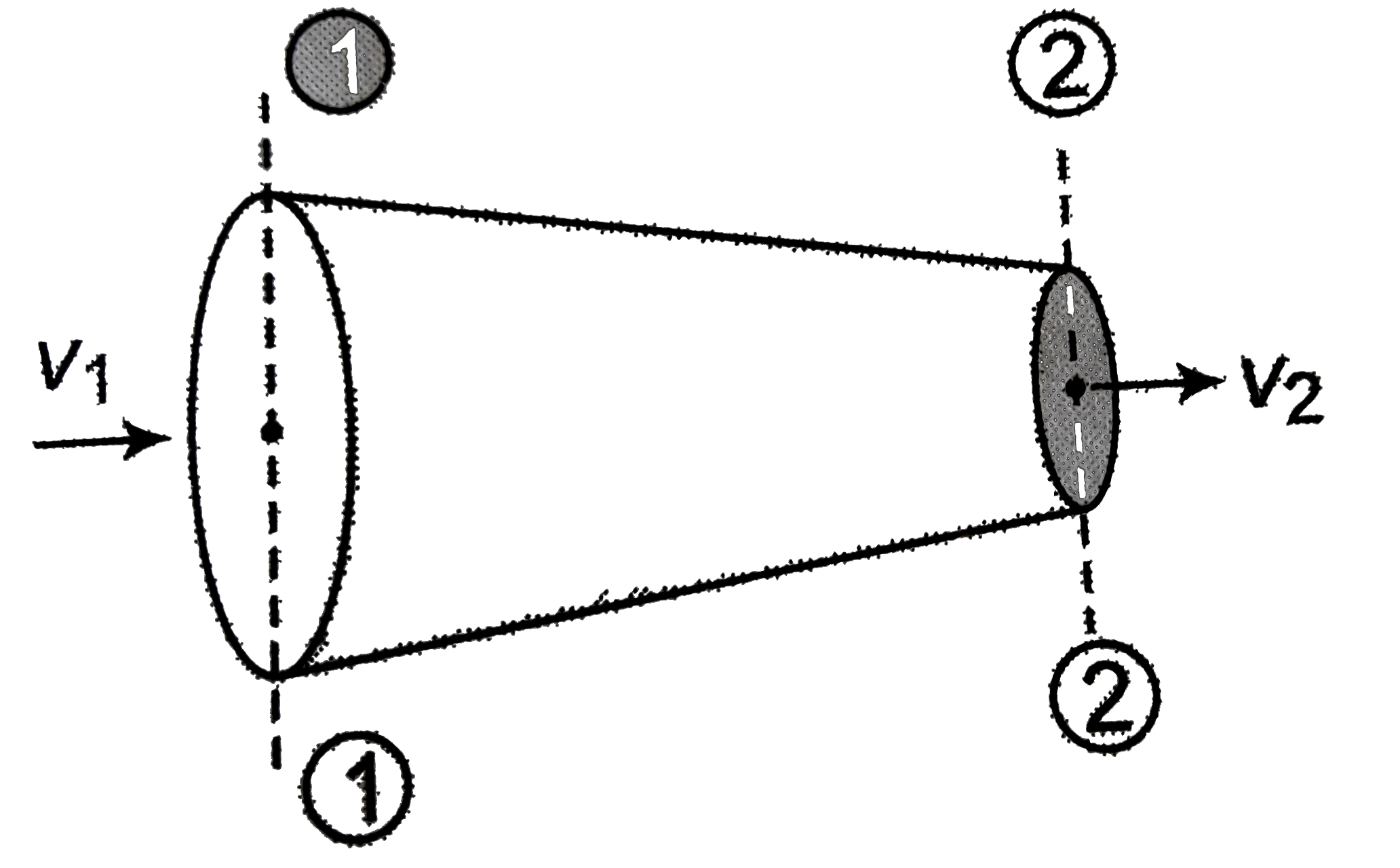Water is flowing through a horizontal pipe of varying cross-section. If the pressure of water equals 2 cm of Hg where velocity of flow is 32cms−1, what is the pressure at another point where the velocity of flow is 40cms−1?
To solve the problem, we will apply Bernoulli's principle, which states that for an incompressible, frictionless fluid, the total mechanical energy along a streamline is constant. The equation can be expressed as:
P+12ρV2+ρgh=constant
Since the pipe is horizontal, the height (h) remains constant, and we can ignore the potential energy term (ρgh). Therefore, the equation simplifies to:
P1+12ρV21=P2+12ρV22
Step 1: Identify the known values
- P1=2cm of Hg
- V1=32cm/s
- V2=40cm/s
Step 2: Convert pressure from cm of Hg to a consistent unit
The density of mercury (ρHg) is 13.6g/cm3. We will convert the pressure into dynes/cm² for consistency:
P1=2cm of Hg=2×13.6×980dynes/cm2
Step 3: Substitute known values into Bernoulli's equation
Using the simplified Bernoulli's equation:
P1+12ρV21=P2+12ρV22
Rearranging for P2:
P2=P1+12ρV21−12ρV22
Step 4: Substitute the values into the equation
Substituting P1 and the velocities:
P2=2×13.6×980+12ρ(322)−12ρ(402)
Step 5: Calculate the kinetic energy terms
The density of water (ρ) is 1g/cm3, so:
12ρ(322)=12×1×1024=512dynes/cm2
12ρ(402)=12×1×1600=800dynes/cm2
Step 6: Substitute kinetic energy terms back into the equation
Now substituting these values back:
P2=2×13.6×980+512−800
Step 7: Calculate P2
Calculating the pressure:
1. Calculate 2×13.6×980:
2×13.6×980=26656dynes/cm2
2. Now substitute:
P2=26656+512−800
P2=26656−288
P2=26368dynes/cm2
Step 8: Convert P2 back to cm of Hg
To convert back to cm of Hg:
P2 in cm of Hg=2636813.6×980
Calculating:
1. Calculate 13.6×980=13328
2. Now divide:
P2=2636813328≈1.978cm of Hg
Final Answer
Thus, the pressure at the point where the velocity of flow is 40cm/s is approximately:
P2≈1.978cm of Hg
---
- P1=2cm of Hg
- V1=32cm/s
- V2=40cm/s
The density of mercury (ρHg) is 13.6g/cm3. We will convert the pressure into dynes/cm² for consistency:
P1=2cm of Hg=2×13.6×980dynes/cm2
Using the simplified Bernoulli's equation:
P1+12ρV21=P2+12ρV22
P2=P1+12ρV21−12ρV22
Substituting P1 and the velocities:
P2=2×13.6×980+12ρ(322)−12ρ(402)
The density of water (ρ) is 1g/cm3, so:
12ρ(322)=12×1×1024=512dynes/cm2
12ρ(402)=12×1×1600=800dynes/cm2
Now substituting these values back:
P2=2×13.6×980+512−800
Calculating the pressure:
1. Calculate 2×13.6×980:
2×13.6×980=26656dynes/cm2
2. Now substitute:
P2=26656+512−800
P2=26656−288
P2=26368dynes/cm2
To convert back to cm of Hg:
P2 in cm of Hg=2636813.6×980
1. Calculate 13.6×980=13328
2. Now divide:
P2=2636813328≈1.978cm of Hg
Thus, the pressure at the point where the velocity of flow is 40cm/s is approximately:
P2≈1.978cm of Hg
Topper's Solved these Questions
Similar Questions
It water flows horizontally through a pipe of varying cross section and the pressure of water equals 10cm of g at a point where the velocity of flow is 40cm/s, what is the pressure at another point where the velocity of flow is 50cm/s?
View SolutionWater flows along the horizontal pipe of which the cross-section is not uniform. The pressure is 30mm. Of Hg where the velocity is 0.20ms−1. Find the pressure at a point where the velocity is 1.20ms−1.
View Solution
Knowledge Check
Water flows steadily through a horizontal pipe of a variable cross-section. If the pressure of water is p at a point where the velocity of flow is v, what is the pressure at another point where the velocity of flow is 2v, ρ being the density of water?
Ap+2ρv2Bp−2ρv2Cp+32ρv2Dp−32ρv2Water flows steadily through a horizontal pipe of a variable cross-section. If the pressure of the water is p at a point , where the speed of the flow is v. What is the pressure at another point , where the speed of the flow is 2 v ? Let the density of water be 1gcm−3.
Ap+(32)ρv2Bp−2ρv2Cp−3ρv2Dp−(32)ρv2Water flows steadily through a horizontal pipe of variable cross-section. If the pressure of water is p at a point where the velocity of flow is v, at another point (pressure p'), where the velocity of flow in ηv : The following statements are given below
Ap'p<1, when η<1Bp'p<1, when η>1Cp'p>1, when η<1Dp'p>1, when η>1
Water flows through a horizontal pipe of varying cross-section at the rate of 20 litres per minuts , determine the velocity of water at a point where diameter is 4cm
View SolutionWater flowing steadily through a horizontal pipe of non-unifrom cross-section. If the pressure of water is 4×104N/m2 at a point where cross-section is 0.02m2 and velocity of flow is 2ms−1 . The pressure at a point where cross-section reduces to 0.01m2 is 3.4×10n Pa. What is the value of n ?
View SolutionWater is flowing steadily through a horizontal pipe of non-uniform cross-section. If the pressure of water is 4×104N/m2 at a point where cross-section is 0.02m2 and velocity of flow is 2m/s. What is the pressure at a point where cross-section reduces to 0.01m2 ?
 .
.
View SolutionWater flows through a horizontal pipe of varying area of cross section at the rate 15 cubic metre per minute. Find the radius of pipe where water velocity is 3 ms−1
View SolutionWater is flowing steadily through a horizontal pipe of non - uniform cross - section . If the velocity of water cross - section is 0.02m2 is 2m/s , what is the velocity of water at another point where the cross - section is 0.01m2 ?
View Solution